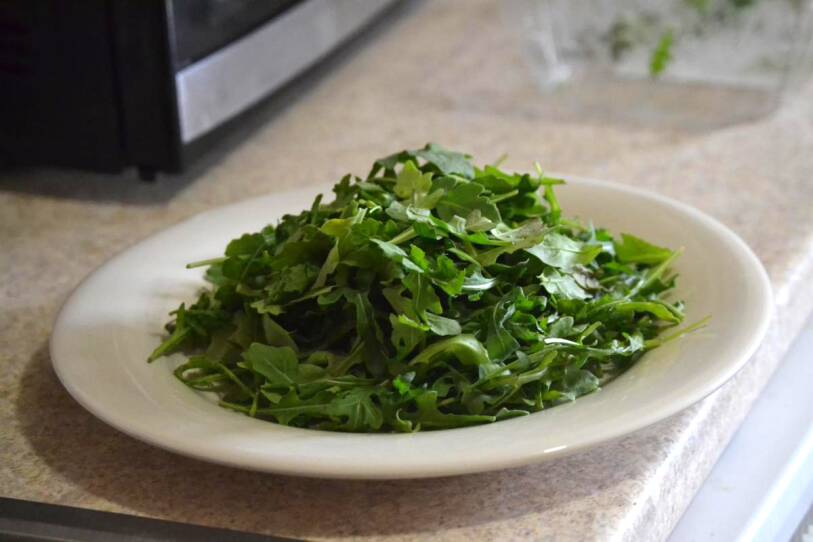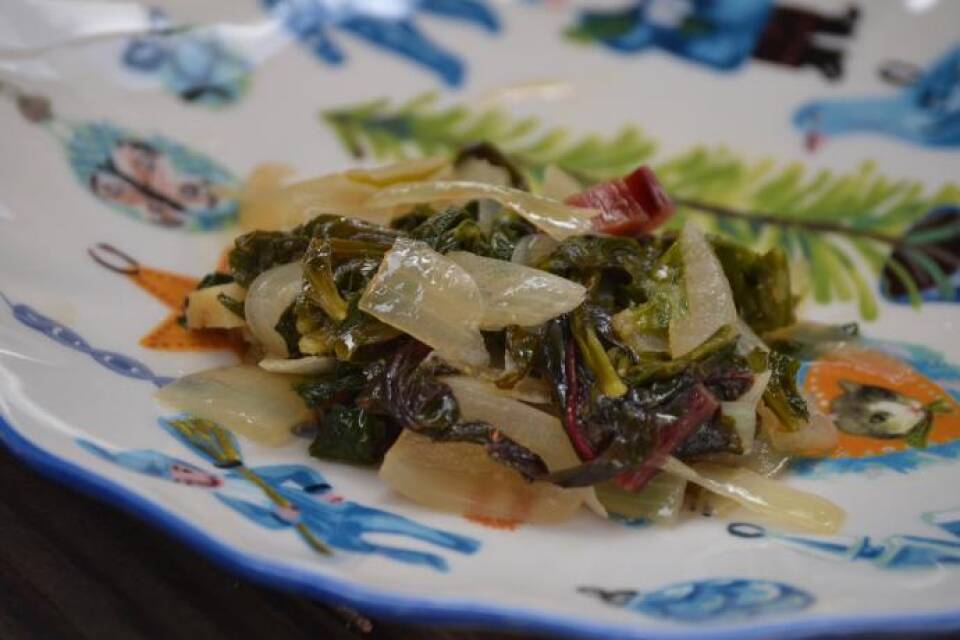I am staring down a bag of arugula, and I know it’s seen better days: The leaves feel velvety and soft, patches of brown peek from behind wrinkled leaves, and little spots of slime make me cringe. I know this is my doing, that if I just avoided the tempting simplicity of takeout, I would be eating fresh, leafy greens with a splash of balsamic and cracked pepper. And still, I ask the question every poor college student asks at one point in her life:
Can I eat this?

More often than not, you can, and in fact, you’re performing a civic act by eating those middle-aged veggies. According to the National Resources Defense Council , 40 percent of the food available in the U.S. goes uneaten, and if Americans dropped that number by even 15 percent, it would equal enough food to feed 25 million Americans . I know, this one bag of arugula won’t solve the food waste crisis, but it’s not helping the problem either. When we throw away massive amounts of food and continue to overbuy, the demand for fresh, blemish-less produce forces farms to cut corners, harming the environment in the process. We use more fuel, more land, and more water ( Americans spend 80 percent of this country’s water on farming and transporting foods ) for food no one will eat.
So by turning this almost-past-its-prime bag of arugula into a meal, I’m doing my part. Go me! Now, how to tackle these borderline greens? I talked to some of Boston’s best restaurateurs, chefs and food writers about how they use aging greens in their home kitchens.
Andy Husbands of Tremont 647 and Smoke Shop BBQ grills them, wilted, with sorghum molasses, smoky ham and lemons. Jamie Bissonette of Coppa and Toro hides them in eggs, a frittata or tortilla Espanola. The crafty folks at Whisk (soon to be Brassica Kitchen + Cafe) ferment them or use them to flavor oils.
Overall, there were two major themes: Hide them in something flavorful, or braise them with something strong. Rebecca Arnold of Allston’s new Whole Heart Provisions uses her greens in after-work soups.
“I make soup all the time when I get home,” Arnold says. “I make sure to always have homemade stock in the freezer. I throw a quart of it in a pot and throw in whatever happens to be in my fridge- it usually ends up being Asian-influenced and spicy. I almost always have an Asian longhorn pepper lying around and that goes in the pot, some noodles or rice, and some greens- maybe a handful of Swiss chard, Napa cabbage or kale. Usually lots of garlic or ginger, some fermented paste of some sort.”
Corby Kummer, restaurant critic for Boston Magazine and columnist for the New Republic and The Atlantic , is on team braise. In his Boston University food writing class, he offered up his own recipe.
“I braise with softened onions, not browned, olive oil, and beef or chicken stock, something that will give it some flavor,” he says.
I decided to try those two routes: The Braise and The Soup.
I thought I would follow a few general principles for both: some fat (stock or olive oil, in this case), some aromatics, sweetness and spice.
First, sort and wash the greens (duh). We’re not trying to get anyone sick here -- if something looks too gross to eat, definitely toss it and give the remaining edible greens a serious rinse.
Next, I began with the braise: I softened half of an onion in olive oil and salt (keep it simple), then I added handfuls of chard leaves and arugula to the pot along with a cup of beef stock, covered and cooked, stirring occasionally so the greens didn’t unevenly brown. I removed them from the heat when almost all of the liquid had evaporated (I like to leave around two tablespoons of broth for serving). Another favorite - the recipe I’ve included here - uses chicken stock and a splash of white wine. It’s a bit sweeter, and the acidity of the wine brings out the natural sugars in the greens.
Since this formula (sautéed onion, greens, stock) can work with many flavor combinations, I tried it again with the miso soup recipe below -- I sauteed the onion with sesame oil, then added the greens with dashi and miso paste. It works just as well, and tastes delicious with a poached egg and rice.

Simple braised greens with white wine
Ingredients:
- 2 tablespoons olive oil
- 1/2 medium onion, halved lengthwise and sliced thin
- 1/2 teaspoon salt
- 4 cups greens (such as chard, spinach or arugula), coarsely chopped
- 1/3 cup chicken stock
- 2 tablespoons white wine
Directions:
- Heat olive oil in a large lidded saucepan over medium heat until shimmering. Add onion and salt, reduce heat to medium-low and cook stirring constantly until softened, about five minutes.
- Add greens and stir until oil coats most of the leaves and the onions are mixed throughout. Add chicken stock and wine, then cook covered, stirring occasionally. When the liquid has almost evaporated, uncover, stir, and season with salt and pepper to taste. Serve.

Spicy Miso soup
Miso, in its sushi-restaurant basic form, consists of four ingredients: dashi (a fish stock made with bonito flake), miso paste, tofu and wakame (seaweed). It’s rich with umami, which is good news for those greens: They can easily hide with the seaweed, and surprisingly enough, greens like arugula play off the nuttiness of the fermented soy. To add a little spice to the mix, I rehydrated my seaweed with rice vinegar and gochujang, a korean chili paste you’ve probably spotted in your bibimbap. You can find dashi, miso, seaweed and gochujang at any Asian market and in the Asian isle of some supermarkets.
Ingredients:
- 1/4 cup dried sheets of wakame, crumbled (about three single-serving sheets)
- 4 teaspoons rice vinegar
- 1 teaspoon Gochujang chili paste
- 2 cups greens (such as chard, spinach or arugula), chopped
- 3 cups dashi
- 4 ounces firm tofu, drained and diced
- 1/4 cup shiro miso paste
Directions:
- Combine wakame, vinegar, and gochujang chili paste and in a large bowl. Let the wakame sit for two minutes in the mixture, until the flavor of the seaweed permeates the marinade, then add your greens and toss; set aside.
- Bring the dashi to a boil then stir in tofu and wakame/greens mixture (with liquid). Lower the heat to medium-high, and bring to a simmer, then remove from heat. Stir in shiro miso paste until dissolved, and serve.




